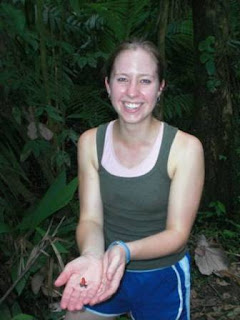
Project Development
My partner for the first IP was a student from University of Washington (Seattle) named Andrés, and after lots of paper-reading and researching, we decided that we wanted to do a project on poison-dart frogs (Dendrobates pumilio). This particular species is very common at La Selva. Adults are small - about 2.5 cm in length or so - and are aposematically colored bright red and blue. Their skin is only slightly toxic (i.e., not dangerous to humans), but this toxicity renders them generally unpalatable to predators. It has been shown that the frogs sequester their skin toxins from their prey, but no research has been performed to examine how this affects their foraging decisions. One important class of skin toxins are the pumiliotoxins, which out of hundreds of ant genera examined, have only been found in the ant genera Brachymyrmex and Paratrechina. Thus, the question we asked was this:

The Plan
Our plan was simple. Trap a frog and put four pumiliotoxin-containing ants and four non pumiliotoxin-containing ants in a container with it, and return later to see which kind of ant the frog prefers to eat. We had five days to perform the experiment and one to put together a presentation... and thus the saga began.

^Me with poison-dart frog.
Day 1
Morning #1 of our IP, and I was already panicking. By then, we should have ideally located both genera of ants somewhere at La Selva, but we had found neither. Andrés and I had spent hours in front of microscopes with giant ant books trying to identify ants we'd collected around the station and in the forest, but that proved absolutely impossible. We trapped ants around the dining hall, in the lab, in the field, and in the forest, and although we obtained lots of ant samples, we couldn't definitively identify a single ant. We also tried and failed to fashion some kind of enclosure for the ants and frogs, but either the ants or frogs (or both) managed to escape from every kind of enclosure we tried. At the end of the day, essentially nothing had been accomplished besides a lot of learning what didn't work.

^Ant identification = impossible.
 ^The Paratrechina ants infesting our lab.
^The Paratrechina ants infesting our lab.
^A few of our containers, complete with frog, ants, and wet cotton ball for moisture. We separated them with cardboard because the frogs are very visually sensitive.
On the fourth day, we finally got another good break. Ronald found me after breakfast, excitedly reporting that he had finally found Brachymyrmex ants crawling around on an Inga plant outside his office. He carefully showed me which ants to look for on the plant, as there were many ants besides Brachymyrmex present. The ants in question were impossibly tiny - less than a millimeter long, black, and not terribly common on the plant. We tried to trap them, but the bigger ants on the plant quickly monopolized the honey in the trap. The only way to catch them, then, was with an aspirator. Now that we were catching miniscule ants, I added about six layers of mesh to the aspirator and went at it. For about three hours I stood in front of the Inga plant, watching carefully for Brachymyrmex to come crawling by and then quickly sucking them up. Each time I trapped four, I put them in a plastic container, to which Andrés added four control Tapinoma ants that we trapped behind the dining hall. After sucking up around 120 ants and catching 30 more frogs, we finally had 30 more frog-ant setups. Problematically, though, still not a single ant had been eaten, and thus we had zero data. At this point we were fully expecting to write a grant proposal instead of a paper, which was our professor's solution to the zero-data problem.

^The end of the aspirator (about 1 cm diameter) and a Brachymyrmex, which is barely visible as a little black dot on the leaf.
Day 5
On the morning of the fifth day, we went to the classroom to count the tiny ants in our containers. We had taped shut each tiny little hole in the lids, so there was no way the ants could escape (or enter!) this time. We could hardly believe it when we started counting ants and - low and behold - we counted less than eight in most containers! We set free the frogs that had eaten ants, and came back later to do more counting after more frogs had eaten. Finally, we had data - hallelujah!
The Ending
In the end, our data showed pretty clearly that the frogs didn't prefer either type of ant (Brachymyrmex or control Tapinoma) over the other. This was still an interesting result, and much of our presentation and papers focused on finding explanations for it. Our advising professor, Erika, was proud of us for sticking with what she said was the most interesting poison-dart frog project she had seen in 15-ish years. The second IP is scheduled for our last site, Palo Verde - hopefully that one will go at least a little more smoothly :)


1 comment:
Interesting article you got here. It would be great to read more concerning that matter.
BTW check the design I've made myself High class escorts
Post a Comment